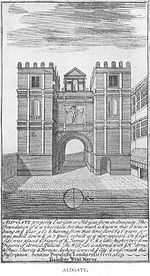Aldgate
| Ward of Aldgate | |
|---|---|
 1600 print of Aldgate |
|
| Ward of Aldgate shown within Greater London | |
| OS grid reference | TQ334813 |
| • Charing Cross | 2.3 mi (3.7 km) WSW |
| Sui generis | |
| Administrative area | Greater London |
| Region | |
| Country | England |
| Sovereign state | United Kingdom |
| Post town | LONDON |
| Postcode district | EC3 |
| Postcode district | E1 |
| Dialling code | 020 |
| Police | City of London |
| Fire | London |
| Ambulance | London |
| EU Parliament | London |
| UK Parliament | |
| London Assembly | |
Aldgate was the eastern-most gateway through the London Wall leading from the City of London to Whitechapel and the East End of London. It gives its name to a City ward bounded by White Kennet Street in the north and Crutched Friars in the south, taking in Leadenhall and Fenchurch Streets, which remain principal thoroughfares through the City, each splitting from the short street named Aldgate that connects to Aldgate High Street. The road is situated 2.3 miles (4 km) east north-east of Charing Cross.
John Cass's school, where a plaque records the former placement of London Wall, is sited on the north side of Aldgate (the street).
The etymology of the name "Aldgate" is disputed. It is first recorded in 1052 as Æst geat ("east gate") but had become Alegate by 1108. Writing in the 16th century, John Stow derived the name from "Old Gate" (Aeld Gate). However, Henry Harben, writing in 1918, contended that this was wrong and that documents show that the "d" is missing in documents written before 1486–7. Alternative meanings include "Ale Gate" in connection with a putative ale-house or "All Gate" meaning the gate was free to all. Other possibilities canvassed by Harben include reference to a Saxon named "Ealh," or reference to foreigners ("el") or oil ("ele") or "awl". Gillian Bebbington, writing in 1972, suggests Alegate, Aelgate ("public gate") or Aeldgate" (Old Gate") as equally viable alternatives whilst Weinreb and Hibbert, writing in 1983, revert to Stow's theory that the name means "Old Gate".
It is thought that a gate at Aldgate spanned the road to Colchester in the Roman period, when London Wall was constructed. The gateway – which probably had two circular towers – stood at the corner of the modern Duke's Place, on the east side of the City, with a busy thoroughfare passing through it. It was rebuilt between 1108 and 1147, again in 1215, and reconstructed completely between 1607 and 1609 “in a more classical and less functional style”. Like London’s other gates, Aldgate was “fortified with porticullises and chained” in 1377 due to concerns about potential attacks by the French. The gate was finally removed in 1761; it was temporarily re-erected at Bethnal Green.
...
Wikipedia

